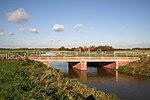Pyewipe Junction engine shed
Buildings and structures in LincolnshireGreat Eastern RailwayLondon and North Eastern RailwayRail transport in LincolnshireRailway depots in England ... and 2 more
Transport in LincolnshireUse British English from April 2014
Pyewipe Junction engine shed was a motive power depot operated by the Great Eastern Railway (GER) located in Lincolnshire, England.The depot was one of the GER's outposts and was located on the Great Northern and Great Eastern Joint Railway (GNGEJR) a few miles west of Lincoln railway station. This map of Lincoln's railways shows Pyewipe Junction in the top left hand corner. It is also the junction for the "avoiding line" towards Newark and Nottingham, which in 2013 is still generally used by freight services or trains diverted by engineering works on the East Coast Main Line which do not call at Lincoln station.
Excerpt from the Wikipedia article Pyewipe Junction engine shed (License: CC BY-SA 3.0, Authors).Pyewipe Junction engine shed
Saxilby Road, Lincoln
Geographical coordinates (GPS) Address Nearby Places Show on map
Geographical coordinates (GPS)
| Latitude | Longitude |
|---|---|
| N 53.236 ° | E -0.573 ° |
Address
Pyewipe Pumping Station
Saxilby Road
LN1 1AX Lincoln
England, United Kingdom
Open on Google Maps










